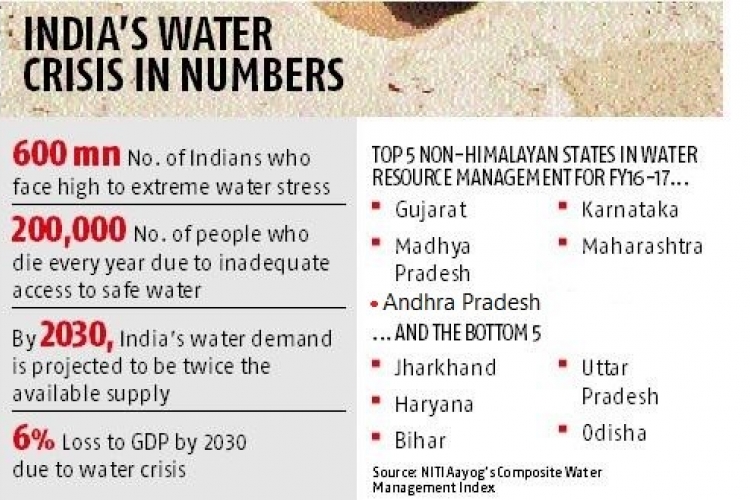COMPOSITE WATER MANAGEMENT INDEX
IN NEWS
The Composite Water Management Index (CWMI) by the NITI Aayog, which was released this June, shows that 600 million people face high to extreme water stress in India. The report, which was published in association with the Ministry of Water Resources, Ministry of Drinking Water and Sanitation and the Ministry of Rural Development, places India at a dismal 120 among 122 countries in the water quality index. It predicts that a persistent water crisis will lead to an eventual 6% loss in the country’s Gross Domestic Product by 2030.
ABOUT THE INDEX
The National Institute for Transforming India (NITI) Aayog has developed the Composite Water Management Index (CWMI) to enable effective water management in India n states in the face of growing crisis.
Objectives of the Index
- The CWMI is envisioned to bring about much-required improvements in water resource management and conservation in India in a coherent and collaborative manner.
- The Index will measure both the overall progress mad e by states in water management and the incremental improvement in performance across time.
The results of the entire exercise will be used to propel action in the states to improve water outcomes, besides improving data collection and performance monitoring mechanisms. The Index is expected to promote the spirit of 'competitive and cooperative federalism' in the country, and ensure sustainable and effective management of water resources.
Themes and indicators
The Index comprises nine themes (each having an attached weight) with 28 different indicators covering groundwater and surface water restoration, major and medium irrigation, watershed development, participatory irrigation management, on-farm water use, rural and urban water supply, and policy and governance.
WHAT IMPROVISATIONS CAN BE MADE
- The CWMI also raises three main issues related to data: limited coverage, unreliable data and limited coordination and sharing. Measuring water consumption by power plants has been a challenge for long. However, it can easily be tackled by using the existing CEA reporting mechanism for daily generation. To do so, daily water withdrawal and consumption reporting should be mandated. These can be measured with existing technology and added into this reporting framework.
- Such information will also help in implementation of the Ministry of Environment, Forest and Climate Change notification which mandates specific water consumption norms for existing and new thermal power plants.
- Information about water stress, power plant siting (location) and so on must be shared seamlessly across departments — a service that the CWMI could perform.
- Factoring in the water-energy nexus linkages, especially the metrics around power plant water withdrawal and consumption, will only help make the Index better and the States better prepared to manage their water and power resources.


 IAS -2025 Prelims Combined Mains Batch - III Starts - 14-04-2024
IAS -2025 Prelims Combined Mains Batch - III Starts - 14-04-2024